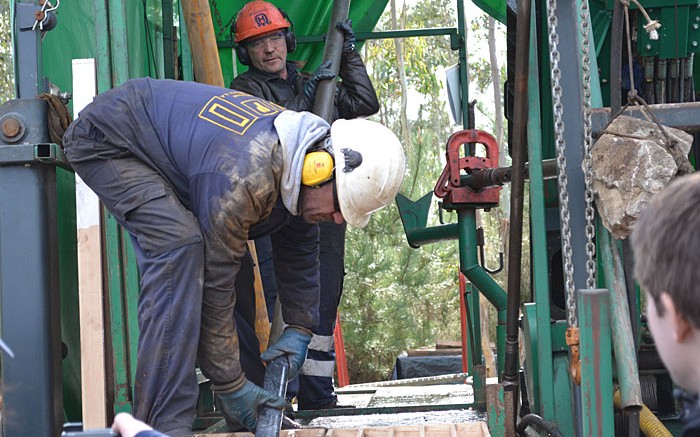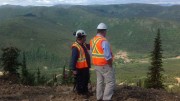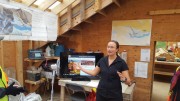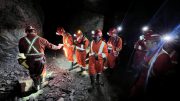LA CORUÑA, GALICIA, SPAIN — It has been three years since Vancouver-based Edgewater Exploration (EDW-V) bought the Corcoesto gold project from Lundin Mining (LUN-T) and embarked upon a journey in northwesternmost Spain’s La Coruna province, where mining history dates back more than 4,000 years.
Now Edgewater stands poised on the development threshold, having pulled together a gold resource in excess of 1 million oz. and putting the finishing touches on a feasibility study slated for release in the fourth quarter.
Corcoesto lies at the end of a leisurely drive on well-maintained roads, 36 km southwest of the port city of La Coruna.
The route traces alongside the deep blue of the Atlantic Ocean, and through seasonal sandy beach communities marked by the colourful hulls of fishing crafts that sway on the tide.
Edgewater’s project sits around 10 km inland from any local agricultural or tourist activities, amongst green hills bristling with thin-trunked eucalyptus trees.
“We have excellent government and community support,” comments vice-president exploration Greg Smith during the drive, pointing out that a local mayoral candidate recently won with a platform that included support for Edgewater’s project. “We’ve been active on this project for the last three years and some of our local team members have been working at Corcoesto since the late 1990s. So we know our neighbours and they know us.”
What Edgewater discovered at Corcoesto was structurally controlled gold mineralization in quartz-arsenopyrite veins, which are often contained in larger zones of silicification with disseminated arsenopyrite in association with sericitic and potassic alteration.
Smith says that the most important regional geological trend is the Pozo del Ingles, which runs northeast to southwest, with the sub-parallel vein systems occurring at right angles.
“The vein structures crosscut all of the main lithologies we’re seeing here, though there is a little bit of influence as you get into the coarser-grained units, where you tend to get more discrete veins, whereas when you get into the finer units you tend to get a series of centimetre- or millimetre-scale veins,” he adds, pointing out the trends and structures on a geological map.
Breaking it down further, Corcoesto contains three vein types that vary based on host rock. Sheeted veins were developed in fine-grained leucocratic orthogneiss, and occur in tight spacing with disseminated arsenopyrite. The second style is the grey-to-bluish arsenopyrite-bearing quartz veins that are common in regional lithologies that include common coarse-grained leucocratic gneiss, biotitic gneiss, paragneiss and schists. Corcoesto’s breccia-style mineralization also holds clasts of brecciated host rock that have been cemented and partially replaced with arsenopyrite-bearing quartz.
A tour group hikes up a forested pathway en route to a drill pad where infill activities continue in support of Edgewater’s upcoming resource update. Smith wields two pieces of core fresh from the rig, demonstrating the types of mineralization, and explaining how he has encountered strong continuity in gold distribution along the east-to-west structures.
“You’ll see a trend develop vertically on some of these structures — sort of a plunge component we have to the mineralization — but that’s a third-order control, with the main controls being along strike and downdip,” Smith says, as he stands atop a section of outcrop. “The structures have been consistent and traceable in all of our holes. We have some great potential to keep following the mineralization to depth. Certainly within those wide, average-grade intercepts we have some narrower high-grade zones that could be amendable to underground development.”
Edgewater is holding off on Corcoesto’s underground potential due to a promising open-pit resource that could lead to a 10-year operation cranking out 102,000 oz. gold annually at cash costs of US$713 per oz. Based on 42,300 metres of drilling, Corceosto holds 21 million inferred tonnes grading 1.76 grams gold for 1.15 million contained oz., at a 0.65 gram cut-off.
Since its maiden resource in May 2011 Edgewater has sunk another 52,000 metres at the site, with infill drilling boosting its measured-and-indicated resources to 5.8 million tonnes averaging 1.74 grams gold for 320,000 contained oz.
Smith says that infill drilling shows more mineralization between the two main structures, which could help the project’s current 8-to-1 stripping ratio assumption.
In late 2011 Edgewater released a preliminary economic assessment (PEA) based on an open-pit scenario that would carry a US$160-million capital exenditure and run at 6,000 tonnes per day over a 10-year life. Corcoesto would generate US$60 million in net annual revenue and feature a US$340-million pre-tax net present value and 34% internal rate of return at a 5% discount rate and a US$1,500 per oz. gold price.
According to chief operating officer John Thomas, Edgewater hasn’t encountered variability in its advanced scoping work, and the company thinks its feasibility study will likely resemble the PEA. Thomas points out a power line on the way to site that Edgewater will reroute to power its operation, resulting in power costs of roughly 10.2¢ per kilowatt hour.
“We’ve done a lot of milling test work, and we’ve decided to put two ball mills in parallel,” Thomas says. “We could have stuck with one, which would have offered us a bit of a cost saving on the power side, but installing two mills will make the operation more reliable in case of any downtime, and also if we go underground in the future we can deal with any lulls in throughput by shutting one of the mills down.”
Edgewater looks set to keep its 6,000-tonne-per-day plant design, and has improved on its recoveries slightly by making its leaching technique on concentrates more efficient, which could improve gold recoveries that now come in at 89%.
On the socio-political side, the Galician government finalized Edgewater’s environmental impact statement in January, which allows for all aspects of Corcoesto — including site layout, plant design, open-pit mining and tailings, and waste storage facility — to move forward.
The government had previously committed to advance the mine as an industrial project to promote investment and new jobs in the region. This designation involves exemption from municipal licence, as the project is seen as a public utility and of social interest, thereby gaining prevalence over competing public interests and able to take on direct subsidies.
“We’ve started buying the land. There are lots of little plots, literally hundreds of them, but many of those plots are owned by the same individual. We’re offering double the market price of the land,” Thomas says at a dinner reception with local Spanish politicians that support the project. “One of the owners is waiting to see if Corcoesto is awarded the final strategic project status, because if it does, expropriation will happen quite quickly.”
When taken as a whole, it looks like Edgewater is on track to meet a production target in the first quarter of 2015.
The company has secured a US$120-million debt financing mandate in June 2012, which is subject to the lender’s review of the pending feasibility study.
In September Edgewater followed up by selling a 1% net smelter return royalty that netted the company another US$4 million.
Assuming the loan comes together, Edgewater will likely need to raise US$40 million to US$60 million more in development capital, depending on how the numbers shake out in the feasibility study.
The company reported US$5.2 million in working capital at the beginning of March, and had
89 million shares outstanding at press time.
Edgewater has traded within a 52-week range of 22¢ and 54¢, and closed at 24.5¢ per share at press time. The company has a diverse equity structure, including 38% institutional ownership and a 5% stake held by producer Kinross Gold (K-T, KGC-N).






Be the first to comment on "Site visit: Edgewater uncovers gold at Corcoesto in Galicia"